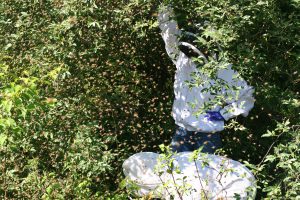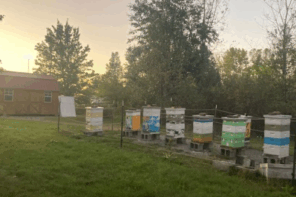Connections
By: Dr. Tracy Farone
I must admit, over these last couple of Winter months (I’m currently writing in early March), I’ve been struggling to find something to write about. It is not that things are not going on. There are several projects “brewing” on my end. However, nothing has fully matured into a full-blown story that I feel would be worthy of sharing for the edification of others. I am sure you all can relate to the Winter time doldrums. For beekeepers, perhaps it is the frustrating feeling of reduced ability to do little for our bees over the Winter and/or anxiety of how many hives are going to make it to Spring.
Personally, I think it is the waiting. But anything worthwhile involves waiting. As a kid, I can remember that turning maple sap into syrup took what seemed like an eternity of boiling, and even longer to turn it into taffy. Fine wine and whiskey can take months and years to produce and refine. Doctors train for eight years in school and then eight to 10 more years in residency and fellowships before being able to fully practice medicine on their own. Babies take nine months to form in their moms’ wombs. Horse babies take nearly a year and elephants gestate for almost two years.
Waiting is a season, but it is never just a season of waiting. It is not passive but a season of preparation, self-improvement, and investment in building connections. Just as honey bee populations seem to explode in the late Spring, be prepared for what you are hoping for, as when results occur, they may unfold very quickly. And you better be ready for it.
Identifying connections that may lead to currently undiscovered solutions to complex problems takes work, time and patience. So, I thought I would give you all a summary update on what is “brewing” on my apicultural plate. All are small strings of a web reaching out directly or indirectly to address some of the major issues beekeeping faces, such as honey bee health, communication and developing the next generation of beekeepers.

Part of “waiting” may be taking the time to form new relationships. In a recent BC article I reported that the Honey Bee Veterinary Consortium (HBVC) has two delegates seated on the American Veterinary Medical Association’s Agricultural Animal Liaison Committee (AVMA-AALC) representing honey bees for the first time ever. Serving as the alternate delegate for only two months, I can report that the honey bee reps were strongly welcomed to the committee, and the committee is very active in reviewing and giving input on federal legislation and regulations affecting agricultural animals. It can only benefit honey bees to have a voice alongside all of the other agricultural animals’ industries, such as cattle, hogs, chickens and aquaculture. An additional new relationship between the HBVC and the Honey Bee Health Coalition (HBHC) has also formed. The HBVC has joined the membership of the HBHC to partner in supporting honey bee health. The HBVC will be sending officers to the HBHC’s meeting for the first time this Spring.
Part of “waiting” may be improvising in serving others. In 2022, I served as a speaker on honey bees for over a dozen events around the country, talking with veterinarians, beekeepers, students and the general community. I’ve also had several meetings on my docket this year, including a community podcast for a radio station in Seattle, WA and the new veterinary bee club at The Ohio State University College of Veterinary Medicine. Most recently, I was asked to speak for the Utah Beekeeping Association Annual Meeting in Salt Lake City in February. Unfortunately, I only got as far as the airport when my plane was delayed to the point that I would miss my connection to Salt Lake. While certainly it was disappointing not being in person, we worked together so I could still deliver my lectures online.
Part of “waiting” may be dealing with fear and frustration. I have recently been contacted by a small scale beekeeper who believes he needs to use Terramycin on his bees for prevention of AFB every Spring and Fall. He was frustrated because he could not find a veterinarian in his area who was willing to see bees, had any knowledge of honey bees, could write him a VFD and/or exam his bees in a legal way. Truth is, he is totally correct in his frustrations and also mistaken that use of antibiotic for prevention of AFB is legal (per the label) in the first place.
Here’s an excerpt from our email conservation:
“We have talked to several beekeepers in our area, commercial and sideliners, about this situation. They have said they will continue to use, no matter what they have to do to obtain it. We understand that Terramycin will not eliminate AFB but will keep it at bay. Once our bees have AFB, we burn and we are out equipment and bees. That is very hard on the wallet. Our idea of the whole situation is, politicians, vets, bee equipment suppliers need to sit at the round table and discuss what the outcome of this whole matter will be. We have again contacted vets in a 200 mile radius and have found none that want to be involved. Sorry to vent on you but we just can’t get answers.”
My response:
“As you know, this is a common concern of many beekeepers, a devastating disease the persists in the dirt that you 100% know is highly contaminated. I get it and I’m not the vet that’s going to tell you to stop, as it’s hard to prove a counterintuitive in the field without risk. Outbreaks are always possible, however statistically unlikely.
It’s also true that beekeepers have been and are using Terramycin (and Lincomycin and Tylosin) on their bees illegally. “Prevention” is not on any label… treatment and control is. It’s always puzzled me about the rationale for Spring and Fall applications… think about it… If the spores are ever present in the environment, wouldn’t you have to treat continuously for “prevention”? I’ve also wondered about the efficacy of using expired drugs and/or drugs obtained through foreign countries which is common practice I’ve been told. Seems like strange places to put your faith.
Clearly a better solution is needed for beekeepers and honey bees. I hope one is on the horizon. Have you heard about the new bee vaccine for AFB? I’ve attached a copy of some information from the company. It’s supposed to be available in April. I have no idea if it’s going to work in the field but larger field trials with commercial beekeepers are underway this Spring. If it does work, it could be a much better solution to AFB and perhaps many of the diseases that plague honey bees.”
Even though I did not have all the answers the beekeeper thanked me for my time and information. Which brings me to the next point…

Part of “waiting” might be investing in research. Progress seems to be an ebb and flow ranging from advancements to catastrophes. Consider a few events that have happened in the last few months. Vaccine(s) are now on the market for honey bees with the promise of an alternate tool that can be used against the dreaded pathogen that causes American Foulbrood with other potential pathogen targets in the future. Will it work or not? We will wait and see.
Consider the train derailment and chemical explosion in East Palestine, Ohio (just five miles from where I lived for 21 years – btw. I just moved out of the immediate area a year and a half ago), how will this effect honey bees in the area? Can the bees act as sentinels for the area? Well, research is underway to answer these questions, but it will take time to determine the results.
Part of waiting may be investing in the next generation. I recently received an email from a little girl named Adeline. She and her parents keep bees and are fans of Bee Culture. She recently wrote to me (you can read part of her message in this month’s Mailbox on page 7) about visiting the College I work for and our apiary. So, on what happens to be my fiftieth birthday, I will have the privilege of showing this budding beekeeper around with the help of some of my older students.
For many beekeepers, May is certainly the time waited for after a long Winter and a fickle early Spring. Spring has finally completely sprung! Now all beekeepers everywhere in the country are going mad trying to keep up with their bees. The season of splitting, swarming and otherwise blossoming bees is fully upon us. What have you been waiting on? What have you been doing in your waiting period? What can you be doing?










